Package Cost – What You Pay and How to Lower It
Ever looked at a shipping quote and wondered why it’s so high? You’re not alone. Most people think the price is just a flat number, but in reality a package cost is a mix of several everyday factors. Knowing what those factors are can help you make smarter choices and keep more money in your pocket.
Key Drivers Behind Your Package Cost
The first thing to check is the weight and dimensions of your parcel. Carriers charge by weight, but they also apply a "dimensional weight" rule – that means a big, light box can cost more than a small, heavy one because it takes up space in the truck. Next, look at the distance. Shipping across the country or overseas naturally costs more than a local drop‑off.
Service level matters, too. Overnight or same‑day options carry a premium because the carrier has to prioritize your item. Fuel surcharges, customs duties for international shipments, and extra handling fees for fragile or hazardous items all add up. Finally, the time of day you book can affect price – many couriers have cut‑off times and charge a higher rate if you book after those windows.
Proven Ways to Cut Shipping Expenses
Start by measuring and weighing your package accurately. Use a kitchen scale for small parcels and a digital freight scale for larger ones. Trim any excess packaging – a tighter box means lower dimensional weight.
Take advantage of flat‑rate services when they make sense. For example, USPS Priority Mail flat‑rate boxes let you ship anything that fits inside for a set price, no matter the weight. Compare live rates on carrier websites or use a multi‑carrier shipping platform to see side‑by‑side quotes. Many platforms also show hidden fees, like residential surcharges, so you can avoid surprises.
Ship during off‑peak times. Early in the week or mid‑month usually sees lower demand, which can translate into lower rates. If you ship regularly, ask your carrier for a volume discount – most couriers will negotiate a better price if you commit to a certain number of parcels each month.
Consolidate shipments whenever possible. Sending a single larger box instead of several small ones often reduces the total cost because you pay one handling fee instead of many. If you run an e‑commerce store, consider using a fulfillment partner that has bulk shipping agreements with carriers.
Lastly, keep an eye on promotions and coupon codes. Couriers frequently run seasonal discounts or offer first‑time shipper credits. Signing up for newsletters or loyalty programs can give you early access to these deals.
Understanding the pieces that make up a package cost puts you in control. By measuring accurately, choosing the right service level, and hunting for the best rate, you can shrink your shipping bill without compromising speed or reliability. Ready to test these tips? Grab your scale, re‑package that box, and compare a few quotes – you’ll be surprised how quickly the cost drops.
Why Is International Shipping So Expensive?
Ever wondered why sending a package overseas feels like it costs a fortune? International shipping prices are influenced by several factors, including distance, customs duties, and global fuel prices. Dive into the details to uncover how these elements inflate costs and explore some handy tips to make shipping more budget-friendly.
© 2025. All rights reserved.

